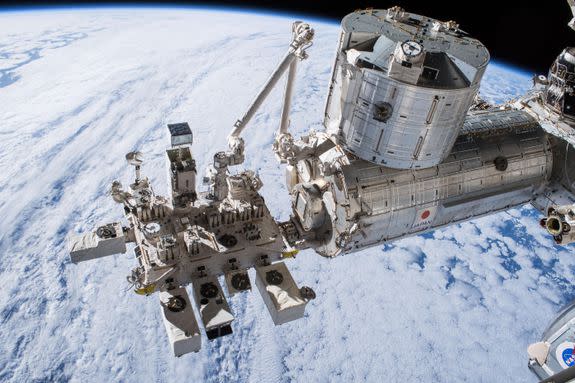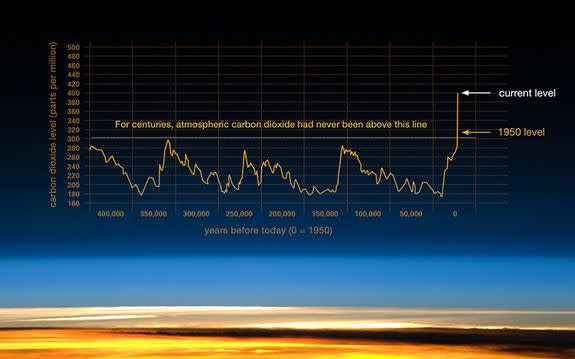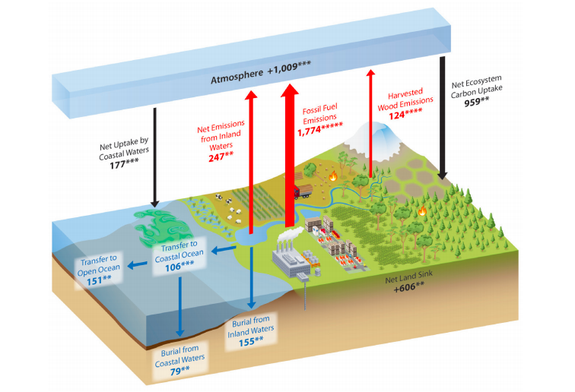Trump fails to block NASA's carbon sleuth from going to space

In early 2017, the Trump Administration tried to ax NASA's Orbiting Carbon Observatory 3, or OCO-3. It didn't work. Then, again in 2018, the White House sought to terminate the earth science instrument.
Again, the refrigerator-sized space machine persisted.
Now, SpaceX is set to launch OCO-3 to the International Space Station in the coming months, as early as April 25. Using a long robotic arm, astronauts will attach OCO-3 to the edge of the space station, allowing the instrument to peer down upon Earth and measure the planet's amassing concentrations of carbon dioxide — a potent greenhouse gas.
"Carbon dioxide is the most important gas humans are emitting into the atmosphere," Annmarie Eldering, the project scientist for OCO-3 at NASA's Jet Propulsion Laboratory, said in an interview. "Understanding how it will play out in the future is critical."
Carbon dioxide concentrations are now the highest they've been on Earth in some 15 million years, and they've likely driven up Earth's temperature to its warmest point in 120,000 years. NASA and the National Oceanic and Atmospheric Administration (NOAA) have confirmed that 18 of the last 19 years are now the warmest on record.
So, knowing exactly where carbon is being emitted, and where the Earth is naturally absorbing some of these emissions, is vital to understanding the planet's fate.
"The really good news about OCO-3 is there will be a continuation of carbon dioxide measurements," Pontus Olofsson, an associate research professor at Boston University who uses satellites to research Earth's carbon cycle, said in an interview.
"The longer the records grow, the more important they become," added Olofsson, who is not part of the OCO-3 team. "It's like an exponential increase in importance."
But OCO-3 almost didn't make it to space.

Image: NASA
"We heard OCO-3 was not going to go," Britton Stephens, a senior scientist at the National Center for Atmospheric Research who works on the OCO-3 science team, said in an interview. "There've been lots of ups and downs in the project."
In 2017, the Trump White House released its budget plans for 2018. It called for "terminating" five earth sciences missions, including OCO-3. In fact, the White House wanted to cut NASA's entire Carbon Monitoring System, and the same situation arose in 2018. But budgetary haggling between congressional lawmakers (who live in districts that support NASA's missions) and advocacy from NASA leaders — almost certainly kept NASA's carbon observing programs alive.
OCO-3 also had a key negotiating benefit: As far as space missions go, it's pretty low-budget. It was built using "spare parts" from its aging predecessor, OCO-2 (currently in space). Critically, OCO-2 is its own free-flying and maneuvering satellite, hurtling around Earth. OCO-3, rather, will be attached to the massive orbiting space station.
"You don't need your own spacecraft," said NASA's Eldering.

Image: nasa
In 2017, the Space Technology and Policy Group concluded that OCO-3 cost "relatively small amounts of money." For reference, the total proposed cuts for the five earth sciences missions in 2017 came to $167 million. Overall, NASA's science budget came to $5.7 billion, with an overall agency budget of over $19 billion.
Although the instrument's funding was in limbo at times, Eldering said her science team kept charging ahead to complete OCO-3, despite the noise. The completed instrument is now sitting at the Kennedy Space Center in Florida, waiting to be loaded onto a SpaceX Falcon 9 rocket.
"We’ve got engineering and science work to do — so we focused on that," said Eldering, who sounded pretty cool and composed about the long, unsteady process. "We know projects can go up and down."
"It’s awesome to have gotten to this point," she added.
On top of OCO-3's bargain price, scientists already know that carbon sleuthing technology works exquisitely. OCO-3 is essentially a discount model of OCO-2 — and OCO-2 can detect the amount of carbon in the atmosphere within a range of less than one part per million.
"In terms of precision, it's incredible," said Stephens. "It's really an amazing feat that it can do that from space."
Detecting the invisible
To see how much carbon is saturating Earth's atmosphere, OCO-3 will rely on sunlight. Specifically, the instrument will look at how much sunlight is absorbed by carbon dioxide molecules.
Every type of molecule reacts to light in a different way, explained Eldering. OCO-3 will look at light that doesn't get absorbed by carbon dioxide and instead gets reflected back into space. The more carbon dioxide in the air, the less light will come back to the cameras.
Flying over land and oceans, OCO-3 will peer down at strips of Earth about 8.5 miles wide (14 kilometers), measuring carbon over disparate cities, oceans, and forests. This will be especially useful for seeing how well cities — and even power plants — are reining in, or mitigating, their carbon emissions.
SEE ALSO: House lawmakers finally let climate scientists set the record straight
"It turns out a huge percentage of carbon dioxide is coming from urban areas," said Stephens. "So if you can quantify the carbon dioxide emissions in Los Angeles, Seattle, or New York City, that would actually be a really useful number to verify our mitigation efforts."
The same thing can be done over forests. Forests are a critical part of Earth's carbon cycle, as they suck loads of carbon dioxide out of the air and store the molecules in trees and soil (that's why forests are known as carbon "sinks"). Though, it's challenging to know how much carbon is released when millions of acres of Amazonian rainforest are razed to the ground. It's equally difficult to know how much carbon gets absorbed back into the earth when forests regrow.

Image: USGCRP 2018, ADAPTED FROM CIAIS ET AL., 2013; COPYRIGHT IPCC, USED WITH PERMISSION
"It's proven hard to estimate such things," said Olofsson.
"You need to observe things over and over and over again to really determine what is going on," he added, citing the importance of OCO-3 following OCO-2.
Today, about half of the carbon humanity emits into the atmosphere gets absorbed into the oceans and forests. "This is a great benefit for society," noted Stephens.
But as the planet warms, the carbon-absorbing abilities of these natural sinks could very well change as more carbon saturates the skies and the planet continues its accelerated warming trend, he said. So these places need to be watched, from above.
NASA 2018 global temperature is finally out! Never mind the little wiggles from year to year - the trend is going relentlessly up, and it will continue to do so as long as we add more CO2 to the atmosphere. Those who still live in denial of this fact are in denial of physics. pic.twitter.com/NqlYFtDr30
— Stefan Rahmstorf (@rahmstorf) February 6, 2019
One of the greatest benefits of OCO fleet is that its continued, precise measurements can be used in concert with carbon measurements on the ground and other earth-observing satellites, like NASA's recently launched, laser-shooting GEDI satellite (it measures the biomass of forests).
This is how scientists gain a confident understanding of the big picture.
"In combination with those instruments [OCO-3] becomes very important," said Olofsson.
"Hopefully there will be an OCO-4," he added.
WATCH: Ever wonder how the universe might end?


